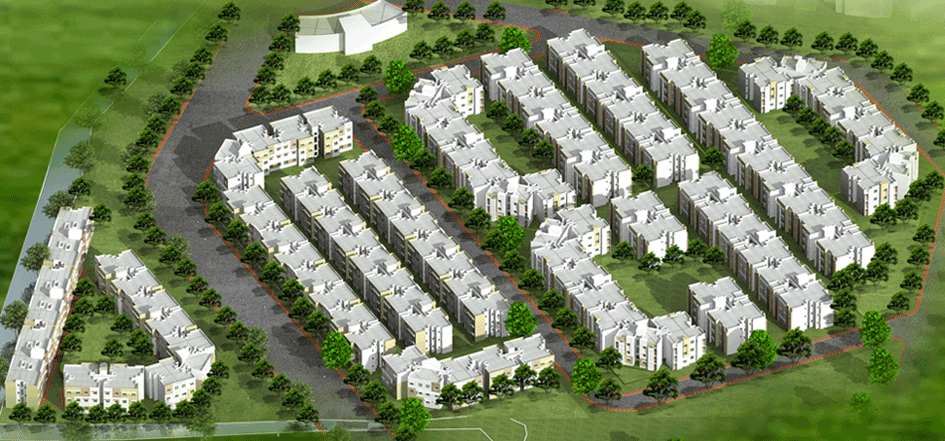On paper, the biggest U.S. export is capital goods–aircrafts, semiconductors, medical equipment, and such. But we’ve been exporting something else in force to developing countries: the suburban lifestyle. From American Village in the Kurdish area of Iraq to “Napa Valley,” a development outside Beijing, the McMansion and its watered lawns are making their way around the world.
Meanwhile, back home, suburbia is falling out of favor and small houses are becoming more popular — at least to gawk at and be inspired by, if not yet to inhabit. So perhaps the next big thing in international architecture will be on the small side: the suburbia of affordable homes.
 A new kind of plan.Tata HousingThat’s the premise behind Shubh Griha, the architectural version of the Nano, world’s cheapest car at $2000 a pop or so. In fact, Shubh Griha — housed in the Mumbai suburb of Boisar — comes from the Nano’s parent company, the Tata Group, which works on everything from painted steel to natural gas exploration. Yes, they’ve got a division for pretty much every ingredient of home building and development; think of them as the Viacom of the engineering world.
A new kind of plan.Tata HousingThat’s the premise behind Shubh Griha, the architectural version of the Nano, world’s cheapest car at $2000 a pop or so. In fact, Shubh Griha — housed in the Mumbai suburb of Boisar — comes from the Nano’s parent company, the Tata Group, which works on everything from painted steel to natural gas exploration. Yes, they’ve got a division for pretty much every ingredient of home building and development; think of them as the Viacom of the engineering world.
While they’ve previously created American-style luxury towers and gated communities–the tallest residential towers in Bangalore, they say, and luxury apartments with Jaccuzzi tubs and mountain views in Gurgaon–Shubh Griha will be a modest affair, with 1,200 units ranging in size from 283 to 465 square feet. The luxury housing sector has taken a hit in India just as it has in the U.S., and India, at least, seems to be responding with creative development. Forget the re-creation of Desperate Housewives‘ Wisteria Lane; this is the Indian version of Levittown.
What makes these units attractive–clearly not capaciousness–is what surrounds them. They are marketed as green, luxurious, and affordable, all the buzz words of modern real estate, with new schools, playgrounds, and a hospital; a rail station to take suburban dwellers into Mumbai; a water harvesting station; community center and shopping and “hawking” zones; and, perhaps most luxurious in the concrete maze of Mumbai, landscaped courtyards. “Green here is seen in a very literal sense,” says June Williamson, author of Retrofitting Suburbia.
The apartments will sell for between 390,000 and 670,000 rupees, something like $8,000-$14,000; somehow, they’re managing to build at about 700 rupees–$14!–per square foot. But the ticket price is still a handy sum in a country where some 500 million Indians live without electricity, and the gross national income per capita is somewhere around $2,460, with millions earning only a fraction of that. “India is in desperate need of affordable housing,” says Williamson. Part of Tata’s market is the huge class of migrant workers who travel to cities, live in cramped rental pads, and send remittances back home. Tata estimates that almost half of the people in the “lower segment” stay in rentals.
So they seem to have figured out what American developers are stubbornly ignoring: that there are many more people on the low end of the economic scale in need of decent housing than there are in the luxury sector, and that low-end buyers are just as susceptible to a green marketing pitch as those at the other end of the spectrum.
“The idea is to understand that opportunity lies at the bottom of the pyramid,” is how Tata Housing’s managing director, Brotin Banerjee, put it at a press conference earlier this month. “This is the safest bet, as there is a huge shortage at this end of the market.”
Of course, this is an easier bet in India, where cheap labor and virgin land abound–$14 per square foot construction costs are impossible here, even if you’re building a cob earth hut with your bare hands. Christopher Leinberger, a land strategist at the Brookings Institution, points out that the most expensive rooms to build are the kitchen and bathroom, and with such tiny units you have ten times the number of them on a small piece of land.
So will these Nano houses make their way to American soil? Not likely, says Williamson: “If you could make money doing it here, people would be doing it.”


